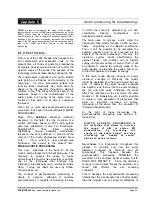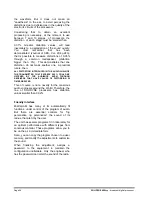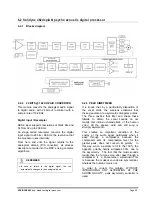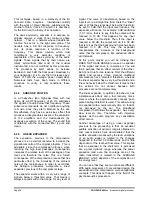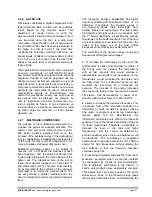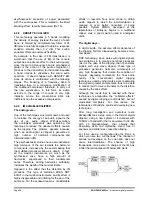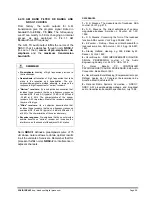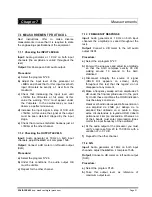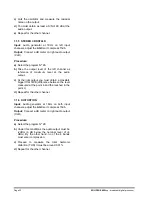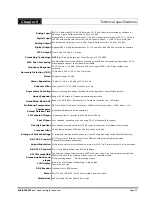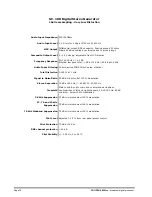
SOLIDYNE 462
dsp - broadcast digital processor
Page 23
Capítulo 6
Audio processing for broadcasting
NOTE:
in order to complement the study of this subject is
recommended to visit our WEB (www.solidynepro.com). In the
DEMO section there are a Power Point presentation called
Audio Processors. It has a complete Technical Appendix that it
analyzes how the audio processing increases the coverage
area of the FM stereo transmission. Also we recommended to
read in our WEB the article “Theory of the multiband
processing”
6.1 A brief history...
From mid of the 1930 decade, when appears the
first compressors and expanders units, to the
present time, all chains of audio for broadcasting
incorporate devices whose function is to alter the
dynamic range of the sound. The advance of the
technology improves these devices during the ‘70s.
The compressors, expanders and audio limiters
were gaining in efficiency and complexity. In the
beginning, its main parameters (attack and
recovery times, thresholds, etc.) were fixed by
design or by the operator, through the device’s
controls. In the '70s, these functions begin to be
automatic, based on the characteristics of the
audio signal, but having at the same time a
control on their action to be able to customize
the sound.
When five or more devices are grouped in same
equipment, they begin to be denominated: AUDIO
PROCESSORS.
Since 1970,
Solidyne
introduces important
advances in this field, like the invention of a
control technique based on FET’s with guided
gate (see publication in Rev. Tel. Electrónica,
September/70). They follow diverse
publications, having particular international
relevance the work published in June/76 at the
Journal of the Audio Engineering Society
, New
York, U.S.A. where a new concept was
introduced, that persist to the present time:
PHSICOACUSTIC PROCESSING
.
This new technique is the base for all the
modern audio processors for broadcasting use. The
necessity to process the phase to make
symmetrical the human voice waveform is another
one of the techniques that Solidyne has
introduced internationally (see mentioned article
AES). Today, our ideas are used by Orban,
Omnia, Aphex, etc.
The concept of psychoacoustic processing is
simple in essence, although of complex
accomplishment. It consists of analyzing the way
in which the sound is perceived by our ear,
considering diverse investigations and
developed acoustic models.
The brain uses to process audio data, the
information that arrives through 30,000 nervous
fibers, originating at the Basilar membrane.
Then, it will be possible to be computed the
auditory reactions and to be governed all the
aspects of the audio processing. This way, the
electronic system works transforming the
original signal into another one, of greater
energy and greater quality of sound. Then, it will
be possible to reduce the dynamic range of the
audio signals, to eliminate the peaks, and even,
to clip them partially to increase its energy.
If this were made directly, obeying to purely
electronic concepts of efficiency, the quality
would be degraded and the sound would be very
poor. If, however, the psycho acoustic concepts
are applied, and factors like the aural masking,
the pre and post pulse inhibitions, the Hass
effect, the reflections at the ear pinna, the aural
models of Dr. Karjalainen, etc; it will be possible
to create a new generation of processors that
allow to important increases of energy,
increasing at the same time the sensation of
“Perceived Sound Quality”.
At the light of these discoveries the
psychoacoustics processing was defined in
these terms:
P H S YC O
A C O Ú S T I C
P R O C E S S I N G
i s
t h e t e c h ni q u e t h a t al l o w s t o i n cr e a s e
t h e
r a n g e
o f
AM
o r
s t e r e o
FM
t r a n s m i s si o n ,
b y
i n c r e a s i n g
t h e
e n e r g y o f t h e a u d i o s i g n al , a n d al s o
i n c r e a s i n g
t h e
“ q u a l i t y
o f
s o u n d”
p e r c e i v e d b y t h e li s t e n e r .
Nevertheless, it is fundamental throughout this
process, to maintain very low the audio
distortion produced by harmonic and IM
components. This happens because the
psychoacoustic processing MODIFIES the
waveform of the complex signal of audio, but IT
DOES NOT DISTORT IT. Since the distortion
concept, in this context, implies the existence of a
sound that offends the ear, sounding
unnatural.
This is because the psychoacoustic processing
obtains that the ear accepts like of better quality
than the original one, to certain modifications of















